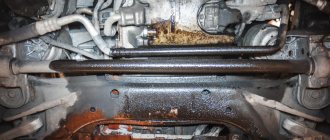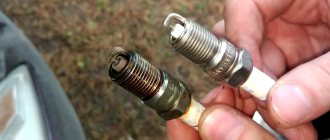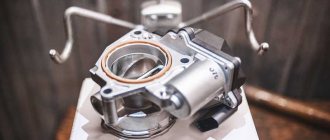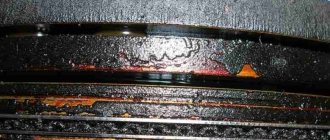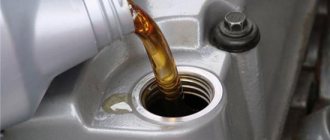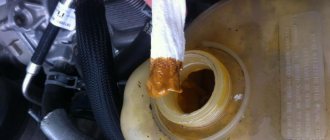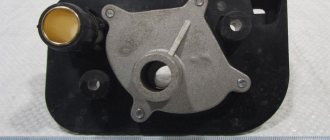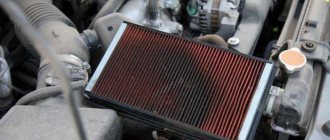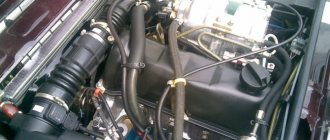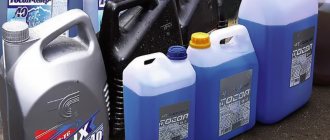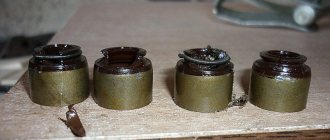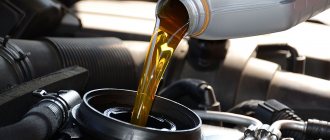If the antifreeze level decreases, but no liquid leaks are noticed from the outside, it means that it is getting into the engine lubricant. The fact that antifreeze goes into the oil is a bad thing, since a loss of lubricating properties occurs, the load on the engine increases, which leads to its failure. This is facilitated by one of the components of antifreeze - glycol. Its chemical properties provoke the formation of an ever-growing potential, which blocks the quality characteristics of the oil.
The most common factors by which you can understand that antifreeze has got into the oil
There are some signs of antifreeze getting into the lubricant. How to determine and detect antifreeze in oil:
- Reducing the amount of antifreeze, provided that it does not leak out of the car.
- The engine is shaking, the motor is running unevenly.
- Whitish traces of antifreeze on the dipstick.
- When you open the valve cover, you can see that it is white on the inside. There are also white spots inside the flask.
- Air bubbles are visually observed in the expansion tank at high engine speeds. There are grease leaks on the surface.
- Antifreeze is visible on the crankcase, spark plugs, under the head, in the pan.
- High concentration of exhaust carbon monoxide. The exhaust color is white, more like steam.
- The grease darkens quickly.
Reasons for oil getting into antifreeze and how to eliminate them
Mixing motor lubricant with engine coolant is a critical malfunction that requires immediate intervention and elimination. In other words, the car cannot be operated, only repaired. Although infrequent, this problem occurs on new and used cars. To avoid costly repairs, the car owner must clearly understand the procedure for his actions when oil is found in antifreeze.
Why does antifreeze get into the lubricant?
If antifreeze or its traces are found, you need to understand the path through which it gets into the lubricant and fix the problem.
Some possible reasons:
- The cylinder head gasket is worn, punctured, or deformed. There is no barrier for antifreeze to leak into the lubricant. This will clearly be observed on the spark plugs. They will be covered in whitish streaks of antifreeze.
- Poor installation of the cylinder head gasket. The head bolts are not tightened sufficiently or, conversely, they are overtightened.
- Lack of tightness of the heat exchanger.
- Head deformation due to harsh operating conditions, overheating.
- Poor quality antifreeze. Could freeze at low sub-zero temperatures. After thawing, such liquid leads to deformation of the block head. And also the use of low-quality fluid leads to the fact that the cylinder liners rust and collapse.
- The fluid pump is clogged or incorrectly installed.
Diagnostics
When the cylinder head gasket
(cylinder head) burns towards the engine compartment, the location of the leak of antifreeze or other liquid from the cooling system can be easily determined by the drip. This is provided that the engine is supervised and washed regularly.
Especially cultured drivers, in order to quickly identify leaks of various fluids circulating in the engine, paint it in heat-resistant silver and regularly wash the engine itself.
On silver, all leaks are detected instantly, which allows you to quickly eliminate the problem. Of course, it is impossible to quickly determine anything on a dirty engine. But freshly squeezing antifreeze out from under the head there is a chance to see it.
The presence of antifreeze in oil is determined by three criteria:
- firstly
, the color and saturation of the exhaust gases change, they become white and swirl with thick steam, in winter it is this steam that confuses drivers - try and determine whether antifreeze has got into the oil or is it from the frost; - secondly
, as an additional check, the color of the oil is checked on the dipstick; if it has recently been changed, but has already turned black, then there is a high probability that antifreeze has got into it; - thirdly
, although slowly, the level of coolant liquid in the distribution tank will decrease every day.
A gradual decrease in the volume of antifreeze is not scary, and may indicate the presence of a breakdown in the gasket
, as well as for leaks in the main line connection bridges or microcracks in the hoses. An exchange of antifreeze and oil can also occur in the heat exchanger due to a leak in the seal.
When the issue concerns only antifreeze, its timely detection of getting into the oil will not cause serious or irreversible processes with the rest of the engine systems.
The situation will be worse when the system contains not antifreeze, but antifreeze diluted with water. In this case, you can expect everything from the engine, including overheating and deformation of the cylinder head.
What to do if antifreeze gets into the oil
Depending on how the antifreeze got into the oil, there are certain ways to troubleshoot problems specific to each case.
| Why does antifreeze get into the oil? | Method for eliminating the cause of antifreeze penetration into the oil |
| Worn cylinder head gasket | Remove and install the block head. Replace seal gasket. |
| The cylinder head gasket is broken. The antifreeze oil partition is cracked. | Crack repair. |
| The gasket is deformed. | Replacement of the internal part of the deformed head adjacent to the motor. |
| The gasket is poorly installed. | Reinstallation, high-quality tightening of bolts. |
| Low quality antifreeze. | Replacing the fluid with a high-quality one. Repair, replacement of gaskets and cylinders. |
| The fluid pump is not installed correctly. | Reinstalling the pump. |
Car oil in antifreeze
The opposite also happens. When motorists see traces of grease on the walls of the expansion tank, they ask themselves the question: “Why is there oil in the antifreeze?”
The car oil from the lubricating complex somehow ends up in the cooling system, but everything is fine with the oil liquid. Its volume, shade, viscosity do not change.
Experienced drivers in such situations say: “The end of the cylinder block.” Usually these words are true. Through a crack in the block, part of the lubricant enters the cooling complex and curls up there. An emulsion is formed.
It is almost impossible to replace the cylinder block on your own. You must contact a specialized service center.
What are the consequences for the engine when antifreeze penetrates into the oil?
Antifreeze is a liquid mixed with concentrated additives: pure water. Additives prevent water from freezing at low negative temperatures.
Antifreeze gets into the oil and causes its lubricating and protective properties to change dramatically. The additives that make the oil a unique material capable of preventing the engine from dry friction, ensuring optimal engine performance at different ambient temperatures, are destroyed.
As a result, the engine wears out quite quickly. Cooling antifreeze, being in the oil, leads to the fact that the consequences for the engine can be catastrophic. There may be a knocking sound in the crankshaft and camshaft. It appears due to abrasion of the friction layer of the liners. When viewed under microscope magnification, white balls of salt are visible on the inserts. They are the cause of abrasion and corrosion of the liners. They are formed as a result of a chemical reaction between lubricant additives and antifreeze additives. During operating mode, the oil heats up and speeds up the reaction.
Another reason for engine problems is that oil additives dissolve better in water than in oil. Antifreeze is water based. Even a small amount destroys a large percentage of additives. Thus, the oil base ceases to have the protective properties declared by the manufacturer. This is why antifreeze is dangerous for lubricating fluid.
Coolant and antifreeze getting into the oil eventually lead to a major overhaul of the engine if the cause of the penetration is not eliminated in time. Even tenths of a percent of coolant in oil are very dangerous for the engine.
In order to promptly notice and eliminate this kind of malfunction, as well as see leaks, you can coat the engine with silver paint that is not afraid of high temperatures.
First steps when antifreeze gets into the oil
In order to eliminate an antifreeze leak, you need to determine the place where it originally appeared (on the head gasket or inside the block itself). If the cause of the leak is a burnt or deformed gasket, then to fix the problem it is enough to replace it with a new part of a higher quality.
If after replacing the gasket the antifreeze leak does not stop, then the reason lies in cracks in the timing head or block. In the first case, the head will have to be replaced completely, since it cannot be repaired if cracks appear. But the block can be welded if you have the necessary skills for this.
After eliminating the leak, be sure to flush both systems. For this it is enough:
- Drain the old oil and spoiled antifreeze from the engine;
- Fill both systems with a special cleaning agent;
- Allow the engine to warm up to operating temperature;
- Drain the cleaner and fill the system with new oil and antifreeze.
It is advisable to wash the cooling system pipes separately, having previously removed them from the car. If cleaning is carried out poorly, there is a risk of the following problems:
- The bearings on the crankshaft will coke, increasing the load on the internal combustion engine;
- The remaining emulsion inside the block will clog the lubrication channels, causing the engine to overheat;
- Most steel elements of the internal combustion engine (crankshaft, valves, camshaft, piston group, etc.) will lose their factory resistance to corrosion.
What actions should I take?
First of all, find out why antifreeze began to leak into the car oil (how to find out the reason was written above). In most cases, you need to change the lining by checking the engine parts. If the block head is in good condition and has no noticeable cracks or holes, then repairs will not be expensive. If there is severe deformation, the worn part will need to be replaced. Remember that there is no point in repairing a broken block head. It's easier to replace it with another one.
Once you have eliminated the root cause, flush the cooling and lubrication system completely. You will need to disassemble the pipes and clean the oil channels. It's quite difficult. The mixture of coolant and lubricant is not easy to remove from parts. Use cleaning products that clean the engine from various contaminants.
Curdled oil in antifreeze negatively affects engine performance. Bearings become coked, lubricant is deposited on spare parts, and the corrosive effect increases. If you ignore the problem, the power unit will jam and major repairs will be required.
When purchasing a vehicle, be prepared for the fact that you will need to carry out maintenance yourself. All recommendations are written in the operating manual. Once you understand how a car works, you are unlikely to pour antifreeze into the lubricant complex.
Such knowledge comes with experience. The more experienced the driver, the more procedures he can perform independently. This makes it possible to save your own money, since you do not need to pay car service employees for work.
To ensure that your vehicle serves you for as long as possible, follow the recommendations prescribed by the car manufacturer in the owner's manual. Fill the engine with only those consumables that are optimal for your power unit. If you find it difficult to choose the optimal cooler/oil, contact an experienced driver or a service center employee. Proper car maintenance is a guarantee of long-term operation of the car.
Antifreeze in the combustion chamber. Symptoms. Diagnostics.
Hello.
Today I wanted to share my experience of checking the engine cooling system for leaks and symptoms of its problems. If a microcrack appears in the cylinder head (cylinder head) or the gasket underneath it burns out, interruptions in engine operation begin. Usually the engine starts hard when cold after being parked for a long time. As it warms up, its performance levels off. In a neglected case, the engine stalls and when hot, the malfunction lamp blinks. When connecting the scanner, there will be errors: misfires in the cylinder into which antifreeze (or antifreeze) gets. At the same time, puffs of white smoke with a specific odor can be observed from the exhaust pipe in abundance. If you unscrew the spark plug, you can see antifreeze vapors. But this is the simplest way to determine when everything is already clear.
But there are times when it is not possible to say for sure whether antifreeze gets into the combustion chamber or not. Usually, car owners periodically add coolant to the tank.
Indirectly, several signs of a leaky cooling system can be identified:
- The level of antifreeze in the tank decreases;
- Poor starting in cold conditions after a long period of parking (accompanied by a short shaking after starting);
- When the engine is warm, the cooling system hoses may rupture. When gases break into the cooling system, the pressure in it increases and if the valve in the expansion tank cap does not work (does not relieve pressure), the hoses rupture. First of all, the old ones are torn. If the main radiator and the heater radiator were on the verge, then a leak begins through them.
The most interesting thing is that the engine runs smoothly and there is not even a hint of tripping.
In this case, it is necessary to make the right conclusion and not make a mistake.
I use the following methods to determine the tightness of the cooling system:
We unscrew the spark plug from the cylinder, which is suspected of getting antifreeze. We set the top dead center (TDC) of this cylinder (so that the valves are in the closed position), after which we pump pressure into this cylinder (6-8 bar) through a special adapter. You may need to fix the camshaft to prevent it from turning. Then unscrew the cap of the expansion tank. Let's watch and listen. If bubbles appear, then the cause has been found.
In fact, this is a reinforced concrete method, but it is very labor-intensive. It's one thing when the engine is simple, but if not, it will take a lot of time and effort.
The second method is very simple. We use a glass flask and a special liquid. Unscrew the cap from the expansion tank and place a flask with liquid in the neck of the tank. Then we start the engine. After several gas changes we can observe how the color of the liquid turns from blue to green. This indicates that there is CO gas in the cooling system, which comes from the engine.
It is worth noting one more verification option. If the engine stalls in the morning and does not start well, then before the next long stop you need to release the pressure from the engine cooling system by removing the cap from the expansion tank, and in the morning screw it on and try to start the engine. If the engine runs smoothly, then you need to go for diagnostics of the engine cooling system.
I hope the article will be useful to diagnosticians and car enthusiasts.
Why is water or coolant in oil dangerous?
If water and coolant get into the lubricant, the density invariably increases, while the fluidity decreases, as a result of which the engine is poorly lubricated and increased wear occurs. As a rule, the piston pins, camshaft and crankshaft are affected. If the car owner, in the presence of such problems, does not repair the engine, this leads to complete failure of the power unit, which can no longer be restored.
The resulting emulsion can get into hard-to-reach cavities, where it will soon coke, which leads to the pistons getting stuck in the rings. It should be said that repairs in this case will be very difficult, since washing out such contaminants and coked oil will be problematic. It is necessary to completely open the engine, eliminate the cause of water getting into the oil, and also perform a complete cleaning of the engine.
If there is water in the oil, problems are observed in the operation of the piston group, which in turn leads to increased fuel consumption.
The coolant will go into the oil, and therefore certain difficulties will arise with cooling the engine. As a rule, this leads to an even greater aggravation of the problem, the geometry of the valve cover and engine jacket is disrupted, numerous cracks appear, and as a result, it is not possible to repair such an engine and the damaged motor has to be replaced.
